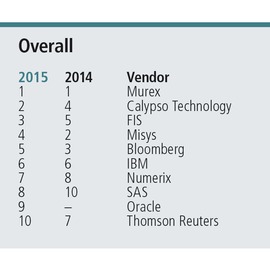
Risk technology rankings 2015: Surgery, instead of plasters
Banks want an integrated solution to the many different regulatory costs facing the trading business – creating a demand for flexible, cross-asset systems that can cope with capital, credit, and funding impacts. Vendors are doing their best to deliver. Reporting by Clive Davidson. Research for this year’s Risk technology rankings was conducted by Max Chambers for Risk, with independent validation of the results by Chartis Research

Over the past 12 months, a number of big, incoming bank regulations have swum into sharper focus and – as a result – so has the scale of the task facing the industry.
"Twelve to 18 months ago, banks' response to the regulatory challenges they faced was to apply sticking plasters; now it is more a case of open-heart surgery on their infrastructure," says Sadiq Javeri, product strategist for capital markets at London-based Misys, which came fourth overall in Risk's annual ranking of technology providers.
The cost, complexity and implementation time associated with reforms such as the Fundamental review of the trading book (FRTB) is driving banks towards a more strategic approach. "Institutions are struggling with an unending avalanche of new regulations – putting in place ad hoc solutions to cope with one piece of regulation at a time is not a cost-effective or sustainable approach," says Maroun Edde, chief executive officer of Paris-based Murex, which came first overall in the rankings.
Instead, says Edde, something more efficient is required: a risk and regulation framework in which sophisticated risk computations are embedded at every step, from trading through to risk reporting and operations, with position information distributed across the organisation in real time. "The key objective is the optimisation of capital charges and, more generally, of all factors impacting the total cost of trading – capital, credit risk, funding and collateral."
Pedro Porfirio, chief product officer at Calypso Technology, sees it the same way, adding that cost-cutting is also contributing to the challenge, as greater demands are now being made of technology: "Trading desks are becoming leaner. As a result, a centralised view of risk and having the ability to calculate marginal capital needs and costs for each trade is fundamental for our clients to determine the profitability of their businesses," Calypso placed second in Risk's rankings.
For vendors, there are big practical impacts. Analytical platforms need to apply on a cross-asset basis, and to encompass and integrate new regulatory calculations as they emerge or change. One practical illustration is the growing list of valuation adjustments banks must apply when pricing a derivative. Following the Basel III capital charge for credit valuation adjustment (CVA) – to reflect shifting counterparty exposure – have been new adjustments for funding, capital and collateral, known collectively as XVAs. Each adjustment requires specific analytics, but can take advantage of centralised calculation engines and other common functionality in a centralised platform.
Sensitivities and profit and loss (P&L) attribution are more important within this family of adjustments because of XVA desks' need to demonstrate the accuracy of their modelling under the FRTB, says Satyam Kancharla, chief strategy officer for New York-based Numerix, which came seventh overall in the rankings.
"Regulators are going to look at every trading desk individually to make sure they are doing a good job of managing their P&L via hedging, and only then are they allowed to maintain their internal model instead of having to revert to a standard model," he says. The issue rose initially for Numerix at a large US insurance client hedging its variable annuity book, in support of which the company added P&L explanation and attribution functionality to its risk analytics platform, says Kancharla.
 A number of vendors are responding to the banks' drive for a more holistic and strategic approach to compliance by bundling up their regulatory functionality into integrated packages, with the addition of some surprising features in certain cases. In December, IBM launched IBM Regulatory Compliance Analytics, a cloud-based application that combines its IBM OpenPages governance, risk and compliance product with Deloitte regulatory content and the artificial intelligence capabilities of the IBM Watson Cognitive Computing supercomputer.
A number of vendors are responding to the banks' drive for a more holistic and strategic approach to compliance by bundling up their regulatory functionality into integrated packages, with the addition of some surprising features in certain cases. In December, IBM launched IBM Regulatory Compliance Analytics, a cloud-based application that combines its IBM OpenPages governance, risk and compliance product with Deloitte regulatory content and the artificial intelligence capabilities of the IBM Watson Cognitive Computing supercomputer.
"The solution enables firms to effectively determine the controls required for regulatory compliance and assess their existing internal control coverage. By quickly navigating through large volumes of regulatory documentation, the solution allows users to automate the parsing of regulations to the specific obligations for business lines and to identify gaps in their control framework," says Andrew Aziz, director of strategy, research and quantitative finance for risk analytics at IBM.
Murex has similarly been bringing together compliance and reporting functionality in its MX.3 Risk and Regulatory Suite. Of necessity, such packages require a component approach to allow for the timely addition of new functionality as new rules emerge. The publication in March last year of the Basel Committee on Banking Supervision's standard approach for counterparty credit risk (SA-CCR) is a case in point.
Real-time calculation
The new method applies to organisations not taking an internal model approach to measuring the counterparty credit risk associated with over-the-counter and exchange-traded derivatives and long-settlement transactions. In December, Murex introduced an SA-CCR component for its risk and regulatory suite that offers real-time or batch exposure-at-default calculation on a wide range of vanilla and complex instruments. "Real-time calculation allows risk officers to monitor the contribution of new trades to the overall SA-CCR number and enables traders to adjust their trading decisions," says Edde.
Although the deadline for SA-CCR implementation is January 1, 2017, many banks are keen to get to grips with the standard early because of the critical role it will play in capital calculations. This includes many institutions that have been using an internal model approach until now, says Javeri at Misys: "Many organisations that have been using quite sophisticated CVA models have indicated they are going to revert to the standardised approach as the SA-CCR regulations come in. There will still be large players looking to do their own modelling and get internal model approval for CVA, but the bulk of our clients will take a standardised approach going forward."
Banks are also having to deal with the impact on profitability of the new regulatory regime, leading to a massive cost-cutting drive for trading businesses. Again, piecemeal approaches are proving ineffective, vendors claim.
"We've seen many banks try to lower their cost per trade by consolidating front-to-back-office processing on an asset-class-by-asset-class basis. Unfortunately, each of these consolidations takes about a year, so achieving full front-to-back transformation of every asset class for regulatory reporting or enterprise risk management can take several years," says Javeri. A more successful approach is to install a consolidated cross-asset back-office platform that will interface with all front-office systems, he argues – an approach Misys recently implemented at French financial services provider Natixis. Such an approach can reduce cost per trade by 25–35%, claims Javeri.
With each new regulation adding to the list of calculations banks must perform – the FRTB alone potentially requires 63 separate expected shortfall calculations, for example – and in ever-tightening timeframes, computational performance continues to be a challenge for banks. Vendors are continuing to employ high-performance computing and data management technologies such as graphics processing units (GPUs), cloud computing and in-memory data handling, as well as exploring analytical approaches, such as adjoint algorithmic differentiation, or simply being more discriminating in how they calculate exposures across trading books.
We are focusing on expanding our capabilities in commodities, foreign exchange options, precious metal cash and precious metal options due to increased client interest in all of these asset classes – Brian Traquair, FIS
"Large portions of many trading books are linear, therefore there can be significant improvements in the speed of calculating exposures by taking an analytical approach where possible," says Numerix's Kancharla.
Other areas where vendors are having to respond to market developments include new models for prolonged negative interest rates, with associated testing and validation functionality, and support for a broader range of asset classes.
"We are focusing on expanding our capabilities in commodities, foreign exchange options, precious metal cash and precious metal options due to increased client interest in all of these asset classes," says Brian Traquair, group executive vice-president of capital markets at FIS Global, based in Florida, which completed the acquisition of SunGard and its trading and risk technology in November, and which came third overall in the rankings. The expanded capabilities include risk analytics and other tools to manage trading activity, and monitor and analyse aggregated position values, as well as links to a range of relevant data sources.
In the independent valuation arena, where regulation such as the Markets in Financial Instruments Directive and the European Market Infrastructure Regulation demand institutions demonstrate pricing transparency and best execution, the ability to efficiently challenge counterparty prices has become increasingly important. To this end, New York-based Thomson Reuters, which ranked tenth overall, launched a fixed-income price challenge tool for its Thomson Reuters Pricing Service (TRPS), in April. Called AskTRPS, the tool provides a mechanism for submitting and resolving evaluated pricing challenges and creating customised reports for boards and auditors, including the number of challenges, asset-class breakdowns, percentage changes and directional movement.
"At a time of rising market volatility and increasing regulatory oversight, our price challenge mechanism answers a clear need in the fixed-income community," says Jayme Fagas, global head of valuations and transparency for Thomson Reuters Pricing and Reference Services.
While the established vendors continue to dominate the rankings, they are keeping a weather eye on developments in the burgeoning ‘fintech' sector, where start-ups are looking to use new methods and technologies, such as software-as-a-service, crowdsourcing, block chain and distributed ledgers, and apps on mobile platforms to disrupt established markets and their providers. Investment in fintech firms is expected to show an increase of 66% to more than $20 billion in 2015, according to a recent report by KPMG and H2 Ventures. While much of the activity is currently focused on back-office functions such as payments, there are a number elements of the risk measurement and reporting process, such as the provision of reference and derived data or calculation parameters, where innovative approaches can solve problems and lead to new services, suggests Numerix's Kancharla.
One example already underway is the crowdsourcing utility being built for the International Swaps and Derivatives Association's standard initial margin model by Ice Benchmark Administration to meet new margining rules for non-cleared derivatives. Another that is in a more speculative stage is the use of ‘smart contracts' – trusted, automatically executing protocols in a block chain – for speeding up the drawn-out settlement processes of certain instruments, such as loans or emerging market bonds. This is a development Misys, for one, is monitoring, although Javeri expects the technology will need to be proven in a consumer mass market before it is brought into the capital markets.
Only users who have a paid subscription or are part of a corporate subscription are able to print or copy content.
To access these options, along with all other subscription benefits, please contact info@risk.net or view our subscription options here: http://subscriptions.risk.net/subscribe
You are currently unable to print this content. Please contact info@risk.net to find out more.
You are currently unable to copy this content. Please contact info@risk.net to find out more.
Copyright Infopro Digital Limited. All rights reserved.
As outlined in our terms and conditions, https://www.infopro-digital.com/terms-and-conditions/subscriptions/ (point 2.4), printing is limited to a single copy.
If you would like to purchase additional rights please email info@risk.net
Copyright Infopro Digital Limited. All rights reserved.
You may share this content using our article tools. As outlined in our terms and conditions, https://www.infopro-digital.com/terms-and-conditions/subscriptions/ (clause 2.4), an Authorised User may only make one copy of the materials for their own personal use. You must also comply with the restrictions in clause 2.5.
If you would like to purchase additional rights please email info@risk.net
More on Risk management
Many banks ignore spectre of SVB in liquidity stress tests
In ALM Benchmarking exercise, majority of banks have no internal tests focusing on stress horizons of less than 30 days
Quant Finance Master’s Guide 2026
Risk.net’s guide to the world’s leading quant master’s programmes, with the top 25 schools ranked
ALM Benchmarking: explore the data
View interactive charts from Risk.net’s 46-bank study, covering ALM governance, balance-sheet strategy, stress-testing, technology and regulation
Staff, survival days, models – where banks split on ALM
Liquidity and rate risks are as old as banking; but the 46 banks in our benchmarking study have different ways to manage them
CME faces battle for clients after Treasuries clearing approval
Some members not ready to commit to 2026 start date; rival FICC enhances services
AI and the next era of Apac compliance
How Apac compliance leaders are preparing for the next era of AI-driven oversight
Responsible AI is about payoffs as much as principles
How one firm cut loan processing times and improved fraud detection without compromising on governance
Op risk data: Low latency, high cost for NSE
Also: Brahmbhatt fraud hits BlackRock, JP Morgan slow to shop dubious deals. Data by ORX News






